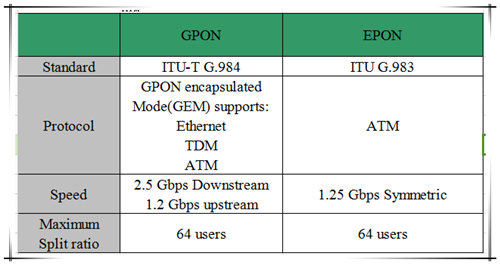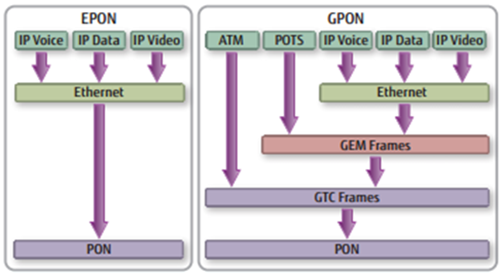Ethernet passive optical network (EPON) and Gigabit passive optical network (GPON), just like the super heroes in the Hollywood movies, which lead the tide of broadband access and optical telecom application, becoming the new hot spot. As fiber access is poised for strong growth, subscribers may wonder how to choose between the two main PON standards: EPON and GPON. The following passage will make a comparison between them.
EPON vs. GPON Standard
EPON, based on Ethernet technology, is compliant with the IEEE 802.3ah (mid-2004) Ethernet in the First Mile standard that is now merged into the IEEE Standard 802.3-2005. It is a solution for the "first mile" optical access network. While GPON, or Gigabit PON, is expected to prevail as a leading optical access technology and to eliminate the bandwidth bottleneck in the last mile. Its requirements were set force by the Full Service Access Network (FASN) group, which was later adopted by ITU-T as the G.984.x standards.
EPON, based on Ethernet technology, is compliant with the IEEE 802.3ah (mid-2004) Ethernet in the First Mile standard that is now merged into the IEEE Standard 802.3-2005. It is a solution for the "first mile" optical access network. While GPON, or Gigabit PON, is expected to prevail as a leading optical access technology and to eliminate the bandwidth bottleneck in the last mile. Its requirements were set force by the Full Service Access Network (FASN) group, which was later adopted by ITU-T as the G.984.x standards.
EPON vs. GPON Data Rate
In EPON, both downstream and upstream line rates are 1.25 Gb/s, but due to the 8B/10B line encoding, the bit rate for data transmission is 1 Gb/s. GPON, on the other hand, supports a symmetrical data rate of 1.25 Gbps in both streams, as well as a data rate of 2.5 Gbps in downstream and a data rate of 1.25 Gbps in upstream. Hence GPON is better than EPON in this aspect. The following table has a brief comparison of GPON and EPON technology in the PON upstream and downstream bandwidth, bandwidth efficiency and the transmission.
In EPON, both downstream and upstream line rates are 1.25 Gb/s, but due to the 8B/10B line encoding, the bit rate for data transmission is 1 Gb/s. GPON, on the other hand, supports a symmetrical data rate of 1.25 Gbps in both streams, as well as a data rate of 2.5 Gbps in downstream and a data rate of 1.25 Gbps in upstream. Hence GPON is better than EPON in this aspect. The following table has a brief comparison of GPON and EPON technology in the PON upstream and downstream bandwidth, bandwidth efficiency and the transmission.

EPON vs. GPON Layering
Besides the above characteristics, perhaps the most striking distinction between the two protocols is a marked difference in architectural approach, especially in layering. The image below will help you to figure it out.
Besides the above characteristics, perhaps the most striking distinction between the two protocols is a marked difference in architectural approach, especially in layering. The image below will help you to figure it out.

In EPON, Ethernet frames are carried in their native format on the PON, which greatly simplifies the layering model and the associated management. EPON employs a single layer that uses IP (Internet Protocol) to carry data, voice, and video.
GPON, on the other hand, supports two layers of encapsulation. First, TDM (Time Division Multiplexing) and Ethernet frames are wrapped into GEM (GPON Encapsulation Mode) frames, which have a GFP-like format (derived from Generic Frame Procedure ITU G.7401). Secondly, ATM and GEM frames are both encapsulated into GTC frames that are finally transported over the PON.
The main purpose of the GEM frame is to provide a frame-oriented service, as an alternative to ATM, in order to efficiently accommodate Ethernet and TDM frames. With GEM, all traffic is mapped across the GPON network using a variant of SONET/SDH GFP. GEM supports a native transport of voice, video, and data without an added ATM or IP encapsulation layer. That’s why GPON supports downstream rates as high as 2.5 Gbits/sec and upstream rates from 155 Mbits/sec to 2.5 Gbits/sec. It is much faster than EPON. However, EPON clearly offers a much simpler and more straightforward solution than GPON. The support of ATM and the double encapsulation of GPON serve no real benefit over a pure Ethernet transport scheme.
Cost Comparison
The use of EPON allows carriers to eliminate complex and expensive ATM and Sonet elements and to simplify their networks, thereby lowering costs to subscribers. Currently, EPON equipment costs are approximately 10 percent of the costs of GPON equipment, and EPON equipment is rapidly becoming cost competitive with VDSL.
The use of EPON allows carriers to eliminate complex and expensive ATM and Sonet elements and to simplify their networks, thereby lowering costs to subscribers. Currently, EPON equipment costs are approximately 10 percent of the costs of GPON equipment, and EPON equipment is rapidly becoming cost competitive with VDSL.
Summary
It is hard to say GPON is better than EPON, or vice verse. They each have their merits and demerits. When it comes to certain IP/Ethernet services, EPON is more suitable and cost effective. While GPON has its own advantages in higher bandwidth, faster transmission rate and supporting triple-play services. Until now, EPON is still the mainstream of PON, especially in the Asian countries, but GPON is expanding quickly lately. Fiberstore supplies a large amount of PON equipment including GPON OLT, GPON ONT, EPON OLT, EPON ONU and PON splitters, etc.
It is hard to say GPON is better than EPON, or vice verse. They each have their merits and demerits. When it comes to certain IP/Ethernet services, EPON is more suitable and cost effective. While GPON has its own advantages in higher bandwidth, faster transmission rate and supporting triple-play services. Until now, EPON is still the mainstream of PON, especially in the Asian countries, but GPON is expanding quickly lately. Fiberstore supplies a large amount of PON equipment including GPON OLT, GPON ONT, EPON OLT, EPON ONU and PON splitters, etc.
Originally published at www.fiber-optic-solutions.com
评论
发表评论